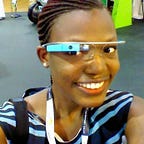Nanodegree and ME, the journey.
In line with the Women Techmakers theme for IWD17, I decided to share my experience with the Android Developer Nanodegree by Udacity and life afterwards. This is the first of two articles.
The Android Developer Nanodegree is one of the numerous Nanodegree programs created by Udacity and Google. It is meant to solidify your Android skill-set and take you from intermediate to advanced level. The course curriculum is created by Google and covers a wide range of topics with practical projects on Android Development reviewed by other Android developers across the world. The projects range from creating apps that sync to a server to building apps with Material Design and for multiple screens, to building home screen widgets, to configuring multiple build flavors with Gradle and integrating with third-party libraries.
Personal perspective
I completed the Nanodegree in February last year after six months of intensive learning. I already had a bit of experience with MOOCs before then though; I was one of the GDG Leads sponsored to take the ‘Developing Android Apps’ course by Udacity before facilitating the Android Study Jams at my local GDG.
When I started the course, I already considered myself an advanced beginner and was looking for any opportunity to hone my skills. I was already quite familiar with learning from videos at my own pace. I also had no doubts about the quality of the content as the course was taught by industry experts. I actually didn’t have a set target time to complete the course though. I was more for doing my best work and learning as fast as I could and seeing how long that took me even though it cost $200 per month so I literally couldn’t afford to go at a very relaxed pace. I was also working full time as an Android Developer then so the only time I had to practice was after work and on weekends/public holidays. Because I didn’t want to miss out on any concepts explained in the videos, I ensured that I watched every video and attempted all the pop quizzes given.
Technical projects
I found Popular Movies, Stage 1 to be relatively easy as I was allowed, encouraged even, to use third-party libraries to help with network and image loading. Popular Movies, Stage 2 was a bit of a challenge then because it was my first time developing for tablets. I remember it was also the first time my project didn’t get approved after a code review. Thankfully, the reviewer was kind enough to highlight areas where they thought I did great work, as well as nicely point out areas where they thought I needed to make changes. My third project was on finding and resolving bugs as well as navigating through and adding features to an existing codebase. Then there was Build It Bigger, a Gradle-intensive project. Before then, I hadn’t really done anything with Gradle and app flavors. Make Your App Material was my best project experience then because I have a thing for beautifully designed apps. Don’t we all? ;) The last compulsory technical project was on Ubiquitous computing, where a watchface that displays the current date, time, and weather based on an already existing Android Application was developed. I wrote a post about my experience developing for Android Wear. Finally, I started Capstone, Stage 1 — Design, the beginning of the final project. Here, I came up with an idea for a project and then submitted it along with wireframes for review. Once the idea was accepted, I started building it in Capstone, Stage 2 — Build.
Non-Technical projects
I also had about five non-technical projects which were based on updating my CV, Github and LinkedIn profiles. They weren’t compulsory as I could do those even after completing the Nanodegree, but I opted to use the opportunity to improve my profiles too.
Final project
GDG NG Events was created for Google Developer Groups (GDGs) in Nigeria to help with managing their events. The GDG Organizers were the admins in the app. Only verified GDG Organizers who had been added to the app by the lead GDG Organizer in Nigeria could create events for their respective chapters. The last set of users were the ones who could select any GDG and see the associated events. They had the option of updating their initially selected group which automatically changed the displayed events. They could also save any event locally.
Firebase was used as the backend for this project. Notifications were implemented with the Batch SDK in collaboration with the Firebase backend, and the users could share events by clicking on the Share icon on the event details page. The icing on the cake however, was that users could hail an Uber to any event from the event details page in the app!
I compiled all my projects from the Nanodegree into one Github repository with each project having its own branch.
Impact
Getting the certificate was never the goal for me; the process from submitting my first project to implementing the final project was. The course was a very big leap for me and I’m all the better for it. While the Nanodegree didn’t teach me everything there is to know about Android development, it was sufficient enough to set me on the right track and it equipped me with enough tools to seek out the rest of the information by myself.
My first experience with Android Wear development was during the Nanodegree and I’ve gone on to build interesting apps with that, one of which is a watch face that tells the time in Yoruba, a native Nigerian language.
I also utilized my knowledge of widgets gained from the Nanodegree to build a time-telling widget for phones.
Are you looking to level up your skills and leave the beginner stage forever? You know what to do!
Thought this was great? Please don’t forget to “Recommend” and “Share”.
